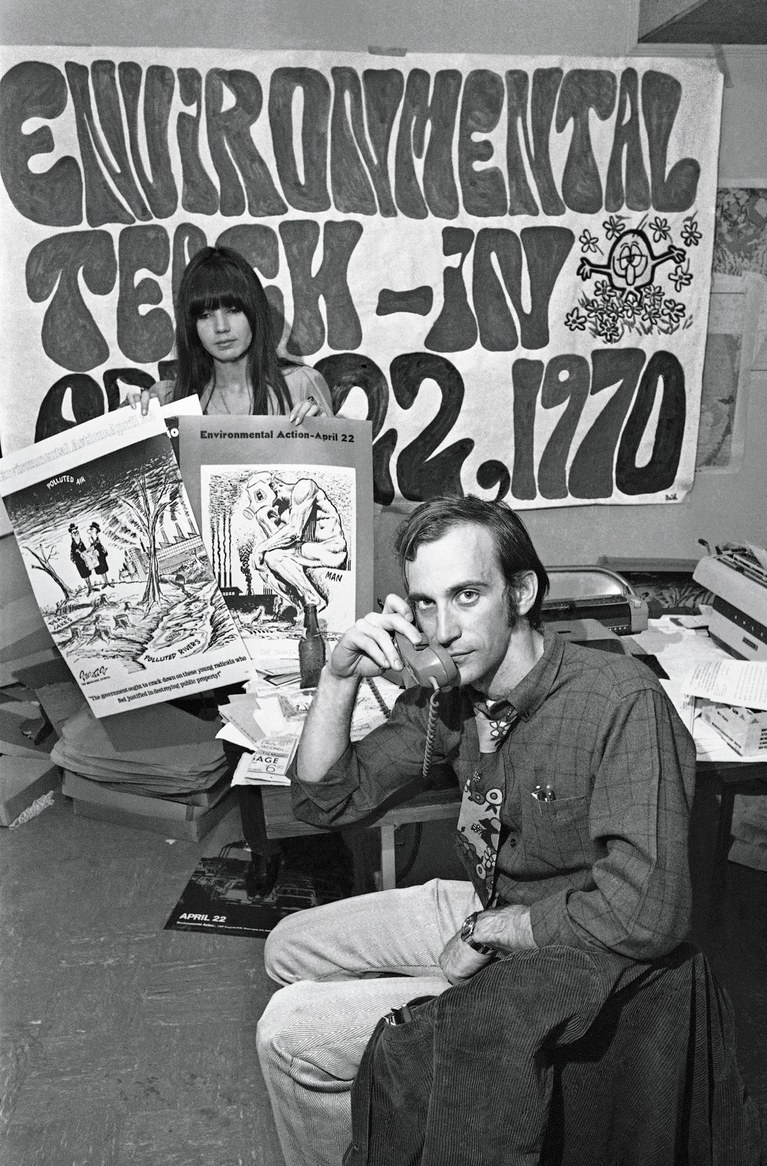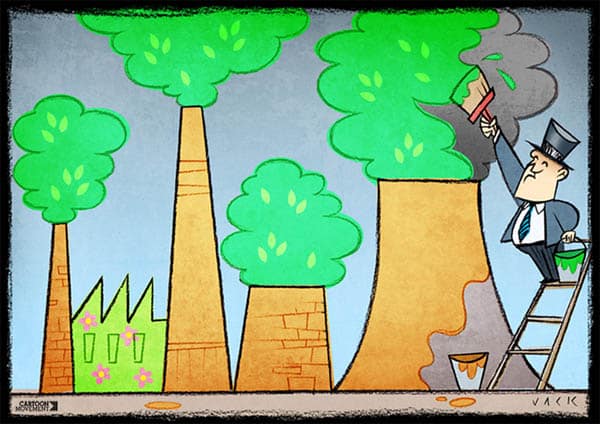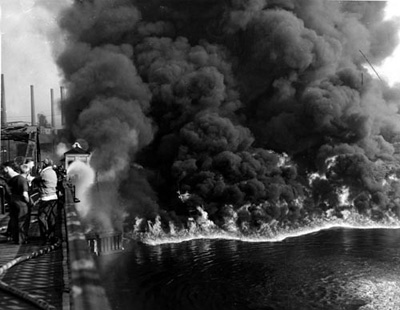By Katie Aplis, Communications Intern

Image source: Smithsonian Magazine
Earth Day has changed in many ways since the original in 1970. The 1960s, often regarded as the era of the civil rights and anti-war movements, was also a time of increased environmental activism. Environmental issue awareness was sparked with Rachel Carson’s 1962 bestseller “Silent Spring”, followed by the Cuyahoga River fire in Cleveland (yes, the river was so polluted it caught on fire) and the Santa Barbara oil spill in 1969.
Inspired by these events, Wisconsin Senator Gaylord Nelson proposed a “national teach-in for the environment.” Although coincidentally held on Sierra Club founder John Muir’s birthday, April 22 was chosen as the first ”Earth Day” based on its timing between spring break and final exams to allow as many students as possible to participate.

Dennis Hayes, head of Environment Teach-In, Inc April 22, 1970. (AP Photo)
On April 22, 1970, thousands of people on college and university campuses, and people in cities across the country took to the streets in protest against environmental degradation. In addition, over 35,000 teach-ins (lectures and discussions on specific topics) were held as a means to educate people on pressing environmental issues to mobilize action for environmental policy.
A few months after the first Earth Day, the Environmental Protection Agency (EPA) was established in December 1970 followed by the passage of the Clean Air, Clean Water, and Endangered Species Acts. The purpose of these agencies and acts is to provide legal and regulatory mechanisms to protect the environment. They did not exist before 1970. The next boost for Earth Day came in 1990, when it spread to other parts of the world, with 141 countries participating and over 200 million people mobilized.

Image source: Pete Dolack
According to the Indypendent the globalization of Earth Day attracted the eyes of corporations interested in using the day as a means to capitalize on the emergence of green consumerism: the idea that consumers want to buy environmentally friendly products. Companies such as Monsanto, Peabody Coal, and Georgia Power ended up sponsoring many 1990 Earth Day Events, and so the corporate green washing began.
We still see “green” packaging flooding the shelves today. Items such as beauty supplies, cleaning products, and clothing are marketed as environmentally conscious to draw in the green consumer. They are appealing to the growing awareness of environmental issues within society and marketing their products in a morally satisfying way to hit the low hanging fruit of environmental action. Consumers get a warm fuzzy feeling about buying a product that claims its environmentally friendly and then continue on with their day, while the corporation behind the branding isn’t pressured to address its larger impact on the environment.
Greenwashing ranges from misleading messaging through words and graphics to masking or exaggerating information about the company’s practices. One instance of greenwashing comes from Tyson Foods, the world’s second largest processor and marketer of chicken. In 2007, Tyson started a campaign stating that their chicken was “raised without antibiotics.” This messaging was found to be untruthful by the USDA almost a year later as Tyson was injecting antibiotics into chicken eggs before they hatched. This is an example of greenwashing through masking and exaggeration of the truth.
Other notorious polluters such as Shell and ChevronTexaco are found sponsoring Earth Day events across the US. These companies, along with hundreds of others, are guilty of greenwashing. When Earth Day rolls around, they routinely boast about the environmentally friendly initiatives that they have contributed to but we need to take these messages with a grain of salt.
Today, Earth Day seems like it has become a day to pledge to take shorter showers, buy a recycling bin for your home, and look at your individual carbon footprint. Now, these are all helpful and necessary actions, but let’s acknowledge that this focus is vastly different from the spirit of the original Earth Day activities. The first Earth Day was politically focused. It was a day of action to urge Congress and local politicians to implement policies for clean air, water, and environmental justice. It was an expression of the need for collective action, for corporate industries and politicians to do their part.
The focus on individual, consumer-oriented action, to me, means big business has co-opted the day and re-engineered it to deflect from its culpability. Instead of focusing attention on the need for policy change, the responsibility has shifted to the individual and our consumption behaviors. But how does environmentally focused consumer behavior measure up to strategic effective policies? In my opinion, individual actions simply don’t have the scale of impact that policies could have.
Why have we accepted this shift?
Have we become cogs in the consumerism machine that Earth Day has become? Maybe it’s because sorting our trash and buying organic soap seems like an easier fix than the often thankless persistence of marching and calling our representatives to improve environmental policies. Or it could be that environmental issues are not as in our faces - visibly obvious - as they were back in the 70s, and so the issues are less immediate in the eyes of enough people. For many communities, though, such as those living along the fence lines of major industrial pollution sources, those visible signs are ever present. But communities that are privileged and powerful enough not to be targeted risk succumbing to the “out of sight, out of mind” disposition.

Cuyahoga River FIre Courtesy of Cleveland Press Collection Via
It’s time for people to make Earth Day theirs again.
Since the new administration has taken office, there has been heightened activism across the progressive spectrum. We are mobilizing and becoming more aware of the power of our voice. Where I live in Austin, and in cities across the U.S., it seems like there’s a march or gathering at the Capital every weekend.
A few months after Trump’s inauguration in January 2017, the first March For Science - a non-partisan series of worldwide marches calling for evidence-based policy - was held on April 22, uncoincidentally Earth Day. More than 1.7 million people across the world participated and made it clear that the Trump administration's blatant disrespect for environmental policy based on scientific consensus wouldn’t stand unchallenged.
The realization (or maybe reawakening) of our power as a people has illuminated a fork in the road on the future of Earth Day. Even as the March for Science and other policy focused mobilizations take place again this year in coordination with big Earth Day events, there have been, and still are, many Earth Day events held across the U.S. that invite speakers whose environmental positions are firmly on the polluters’ side, such as former Texas Governor and current Trump DOE Secretary Rick Perry, EPA Chief Scott Pruitt, and Texas Railroad Commissioner Ryan Sitton.
As we begin the shift in, what I hope is, a positive new direction for Earth Day, we need to keep this momentum going year round. Let’s embody the spirit of the original Earth Day and demand environmental action from politicians and corporations. Let’s celebrate every day like it’s Earth Day.